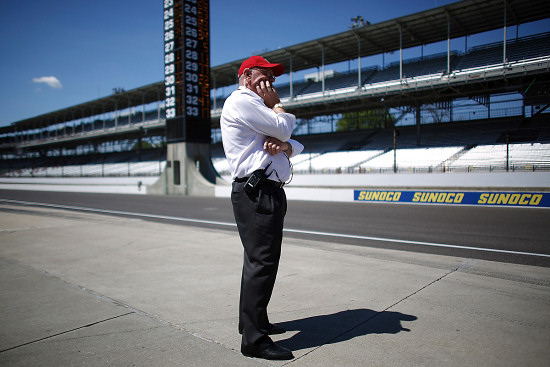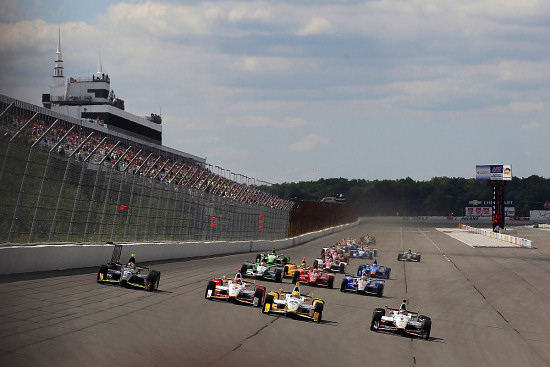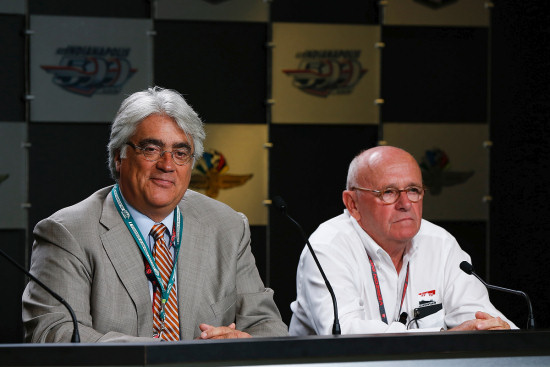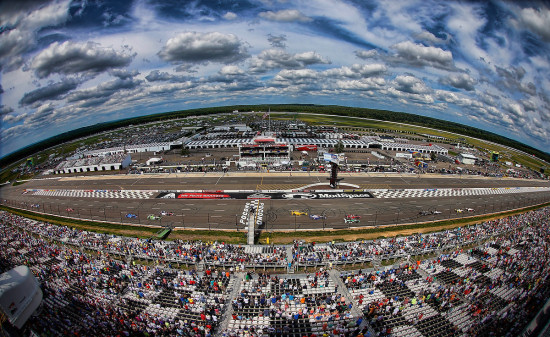The Way It Is/ Derrick Walker on his two years with IndyCarby Gordon Kirby |
 After two and a half years as IndyCar's president of competition and operations Derrick Walker has resigned and hopes to return to the ranks of team owners with his United SportsCar Porsche GTLM team. Walker has spent his entire working life in racing, first as a mechanic in Formula 1 with Brabham and Penske, then as a car builder and team manager for Penske and Porsche CART teams before establishing himself in 1992 as a team owner.
After two and a half years as IndyCar's president of competition and operations Derrick Walker has resigned and hopes to return to the ranks of team owners with his United SportsCar Porsche GTLM team. Walker has spent his entire working life in racing, first as a mechanic in Formula 1 with Brabham and Penske, then as a car builder and team manager for Penske and Porsche CART teams before establishing himself in 1992 as a team owner.
Walker's team won at Portland in 1999 with Gil de Ferran driving and he continued to run his team through 2010. He also expanded in 2010 into what is now the United SportsCar series and in 2011 and '12 he ran Ed Carpenter's IndyCar team before tackling a job with IndyCar which many people have long considered a poisoned chalice. Recently I sat down with Walker to discuss his time with IndyCar and lessons learned by himself, IndyCar or the team owners about the thorny business of running an often contentious, financially troubled form of racing. "I came in with the belief that we should be further away from spec racing than we were," Walker began. "So the goal was changing the system over time to avoid spec racing with the caveat that you've got to control the costs. That seems like a contrast in ideas but I think there are ways you can do that over time.  © LAT USA "I also came in with the belief that the system and the culture internally needed to be changed in a way that was reflective of what the paddock needed, whether that be regulations, race control, or whatever. "I came in with those two ideas. I wanted IndyCar to get out of spec racing and I wanted to change the culture of IndyCar in a new way." But Walker quickly formed a different opinion about many of the people at IndyCar and the challenges they face. "I'm the first to admit that when you see it from the paddock side and when you're inside over on the dark side, it looks completely different from where I was. So honestly I admit that for the last two and half years--and the first year was the worst--I've been very much on-the-job training. "I had to learn to adapt to the fact that there are unintended consequences for change and there are a lot of moving parts to the whole thing. There are a lot of politics and protocol that stops it from being as simple as you might have thought it was going to be. The change I wanted was probably too much too soon. I didn't either have it all baked or I was still needing to find the right formula for making that work. "I also changed my perception on the employees of IndyCar. Like many people in the paddock you condition yourself to always look at the front office and say, it's broken, it doesn't work. I always had the impression that the organization needed fairly radical changes. I thought we needed to get some people out of here and get some fresh blood in.  © LAT USA "I saw them more as a brave bunch that were doing a very good job but they need some overall leadership and, most of all, they needed some support. They needed to be told they weren't that bad, that they were good at their jobs. But some changes were needed. Change was necessary. "I thought I had it figured out but as the year went on I realized that there was so much to do. In this job, a major issue crops up every other week. Sometimes it's an operational thing, sometimes it's something else. Sometimes it's controversial. But it takes whatever your full week of work was and puts you four feet under water. So the work load can be horrendous at times. "I thrived on that part. I'm a workaholic, I think, and I thrived on that challenge. I felt it was my chance to make some kind of a difference, as lofty as that sounds. But I've been involved in Indy car racing since 1977 and I thought there was a chance to come in and make a difference, not change the world, but have some small portion that you improved. "That was my goal coming in but after two and a half years I'm still on-the-job training, like I say. I wish I had another couple of years because I think the longer you're in this job and the more you learn about what hot buttons to push and how to maneuver with the sharks, the better off I would be to accomplish more. "As it is, I leave with a lot of unfinished business and in the eyes of some team owners and perhaps Mark (Miles) as well, maybe I haven't achieved anything or done it right. I feel it's a little bit of a tainted departure for me.  © LAT USA I asked Walker to elaborate on how he made his decision to resign. "I worked at doing the job," he said. "Sometimes I didn't agree with it. Sometimes I struggled with the lack of progress. Sometimes I didn't feel there was enough support. But I kept my head down as a loyal employee and supported the company and did what I thought was best. "My contract was up in June of this year and when it came time to consider the renewal of my contract I thought it was time to make a decision as to whether I would stay or seek other employment. I really felt strongly enough about my opinions but the one thing I didn't want to be was one of those whinging employees in the ranks who are disgruntled with the system. "I think I personally worked very hard to try and make a difference, and when you work that hard you've really got to feel that you want to be here and that you've got the support and are appreciated. And I began to feel that I didn't have that support and wasn't appreciated. "So I made the decision to leave, but after I made the decision I said I can't leave in the middle of the season even though my contract's up. There were major issues like renewing the engine supplier agreements and getting the regulations in place for next year and beyond. And then we had our problems with the cars at the Speedway. "There was a lot of major stuff to deal with but after the particular criticism that came at me from some owners about some of the things that had happened I got the feeling that the company didn't support my efforts. So I basically said I'll make it easy for you. If I'm the problem, I'll leave now. "I was planning to do it over the winter time and do it in a friendly way, just retire from the job and walk away. But then the pushrod failures at Iowa were blamed on me and the department which was total rubbish. So I felt I didn't have the support of the company in my endeavors and I made it easy for them and decided to leave.  © LAT USA "In two and a half years I've never actually had anyone sit me down and tell me what I'm doing right or wrong. I've never had the team owners sit me down and tell me here's where we think you're screwing it up. "So I was very disappointed when these people who I have known for many years and many of them I've worked really hard to help, thought so ill of me. Quite frankly, I was shocked. But the reality is the reality and you accept it and move on. Cutting a long story short, that's the way it came about." Walker ruminated on the difficulties of working with the team owners. "Unfortunately, I was never able to distribute internally to IndyCar or the team owners my view of the future car direction. My view was that we were beginning with the aero kits to move toward a new car. There are numerous reasons for a new car but when I made that suggestion there seemed to be an outcry that, 'We don't have enough money for a new car.' "I was planning to show my proposal at Mid-Ohio for getting to a new car in 2018 or beyond. It depended on if the owners agreed when it would happen. It could be 2018 or it could be 2019 or 2020 but there is going to be a new car. I believed we needed to set a plan and start cracking along towards it to give us enough time to do the job right. But I never made the presentation to them to look at the future. "I wanted to have more time for IndyCar and the team owners to plan for the new car and to get the message out to the fans and media. The fans, the manufacturers and the competitors all want to know where we're going. IndyCar is about the cars and the stars but having a clean sheet of paper for the cars allows you to modify and rub on them, re-think and change.  © LAT USA "If they had been really serious I was going to show them my ideas but it would only have been done with their approval. If they wanted to make it 2020 rather than 2018 that was no problem for me. I don't care when it happens but it should come and it's got to come as far as I'm concerned. "Nobody has ever seen the final, complete version of my 2018 plan or the work we did on the future. It's a twenty page power point presentation. It's pretty simple and it was planned to try to think about and cultivate ideas for the future. But, as I say, I never presented it to them because they didn't want to hear about a new car. "It's not the only way to do it. It was trying to get everyone to focus on the future. When I joined IndyCar I gave them a five-year plan of the aero kit introduction and the homologation program for aero kit modifications. I gave them a plan which I think so far we're on track with and the cost per entry is actually under budget but everybody tells me it's over budget, which is not what I see from the facts I have. I think there's been a bit of disinformation spread about how you add the numbers up. "But be that as it may, the five-year plan was leading towards the development of the new car. We need to find a way to connect with today's youth and the electronic age. We need to decide how we provide the best electronic data to the fans. "I was trying to get a direction and have a plan for the future. That's something I've never heard much of in American open-wheel racing and I'm not saying I'm the only guy who's got the answers. I'm just very much in favor of trying to develop that plan. I think Mark is committed to doing that some day as part of an overall company strategy. "It's not easy but I just squirreled away to try to find a way forward. It was really me saying, what do you think about it? It was never saying, here's what you're going to do. It was about the owners giving us their input about what they think. "As far as the aero kits are concerned, we've made a start and the next step for 2016 are part of next year's regulations. If they don't want a new car in 2018 we can add to the aero kit development in 2017 and '18 which I think would be worth doing because the biggest cost is already done. "If you look at what you can change over the next few years it's a lot more limited but it will be an evolution and it will keep competition among the manufacturers. Whether that will happen or not, I don't know, but to me it seems logical to keep opening up and developing the aero kit through 2018.  © LAT USA "Of course, the first test for the aero kit has been this year where one manufacturer seems to be a little behind. There is a process in the rules for the series to look at it and see if one manufacturer being uncompetitive is detrimental to the series. Then modifications to the aero kits can be approved by IndyCar. "A request has been made to consider that so I'm sure that will come up real soon and we'll see what IndyCar does. We had a plan in the works but now that I'm not going to be there somebody else will figure out how to handle that." One of the many unintended consequences of the CART/IRL war was the destruction not only of Lola and Reynard in the UK but also the final remnants of the American race car industry devoted to building and developing Indy car parts and components. At the same time Dallara has established itself as the world's only manufacturer of open wheel cars from Indy to Formula 3 cars and in this environment it will be extremely difficult for IndyCar to find a competitive or alternate manufacturer to build new cars. In an attempt to break out of Dallara's global monopoly of the production race car market and develop a new model for the Indy car of the future Walker looked at the way Boeing builds its current passenger 'planes. "My outline didn't go into the specifics of the design of the car or what the car should be and who should make it or own it," Walker said. "The intellectual property rights of the car could be owned by IndyCar or the team owners. If you look at Boeing today, the components for their latest airliners aren't all built at the same factory. They're built at factories around the world and there's no reason why you can't manufacture race cars in the same way. You need a concept and then you can go out and get it made, but the series needs to control that process. "People criticize Dallara but given the mindset of what people wanted in building the current car Dallara has been a very good partner for IndyCar. You can argue that they've made too much money or that the car was lacking this or that, but there aren't too many companies that can turn out the cars they did with as little money down as Dallara did." In this space over the past year former Lola and Penske Indy car designer Nigel Bennett has made some very clear suggestions aimed at reducing downforce and tire grip. Also, former Brabham and McLaren F1 designer Gordon Murray has put out his own ideas complete with detailed illustrations for a new F1 car. But nobody in the FIA or IndyCar has had the decency or courage to respond to, let alone embrace Bennett or Murray's concepts for a new F1 or Indy car. I asked Walker why the sanctioning bodies have no interest in asking for the help of highly qualified men like Bennett and Murray. "When you look at the Indy car of the future I think you would be crazy not to look at other concepts from designers of note like Gordon Murray and Nigel Bennett," Walker observed. "I think what the series needs is where I ended up with my outline for the car of the future. I started by saying, what's wrong with what we've got? What don't I like about what we've got?  © LAT USA "I think it would be very productive if you went to Gordon Murray or Nigel Bennett and said this is our simple wish list of what our new car should be. Can you give us your ideas and your concept? The thing that really got me going two years ago was Adrian Newey's X-1. I'm not sure that the closed cockpit is the way to go but when you look at Adrian's design it shows you that you can produce something that's both futuristic and good looking. And I don't think it would cost too much money to build a car like that. "You have to decide if you want more or less wings or underbody to make the racing better. Those things can be worked out but the actual cost of designing something different that's a simple car doesn't have to be too expensive as long as you're not putting a lot of different energy recovery technology with a bunch of electric motors and batteries in it. "I don't think the design architecture of a good-looking but simple new car has to be too expensive. We need something that makes people say, 'Wow!' We need something that's going to capture the imagination of the younger generation. That's what we're missing right now. They're passing us by and we need to reach out and grab them. "To me, that was the big disappointment of the owner's reaction to the concept of a new car. I guess the concept hasn't been properly articulated but they've got to consider a new car. They've got to get the process and dialogue going to see what people we can get involved around the world in manufacturing components or pieces for a new car. But so far it hasn't percolated that way. "I'm sure if you went out to people like the Gordon Murrays, Adrian Neweys and Nigel Bennetts of this world who've been around a long time and have a lot of experience and information at their disposal, they would be very interested in contributing. What's needed is leadership to point a way to a path to that. "There's no reason that you can't have a new car that's sexy and attractive that fits our cost constraints. It can't be something that costs so much that it puts us out of business. When you talk about the cost you've got to think about how you control development over the years. "You've got to put some cost constraints on development and make sure everyone has a chance to buy the new stuff that's out there. You can't have one guy figuring it out and everyone else has to wait five years before they can get it. That would kill our series. Our model is obviously different than in Formula 1 or other series. It needs much more cost and development management.  © LAT USA "If IndyCar is not moving forward with steering the series, then who is? IndyCar has a responsibility to show leadership and in order to go in a new direction you certainly want your constituents to be part of it. They're going to pay for it and they've got a lot of experience, but I don't believe you can't not go down that road. Again, the series needs to show leadership." For his part, Walker will spend the next few months looking for sponsorship to replace Falken Tire as the primary backer of his USC GT Le Mans team. "I'm going to go back to running my team and business," he remarked. "I've got some good people and they've kept the team in good shape over the past two and a half years. I don't know exactly what we're going to do. I've got to get on the treadmill and find the money and look at other programs like Global Rally Cross. I'm not restricted to anything. If I can find the money I'd like to continue in the USC and maybe other forms of racing. "IndyCar is not out of the question. I could come back with my own race team at Indianapolis and bitch about race control and aero kits! But I would come back with a hugely different attitude. I think I was pretty loyal to Indy car racing when I had my own team, but I think I would come back with a whole new attitude compared to anything I've ever had before. "I want to stay engaged. I've got some good employees who I want to keep working for me. Providing a race team for Falken Tire was only one part of the program. We also provided a testing program for them to help better understand the data and what we do with it. We learned some amazing things about tire distortion. We had a lot of data and infra-red cameras providing us information. We tried to build systems that identified any problems for the drivers before they became problems. "It's been an interesting exercise and rewarding in some respects because we're the only car with those tires and it's a somewhat difficult car with the weight distribution issues in a Porsche. But on the days when the team had a great pitstop strategy and the tire was durable it was rewarding to actually succeed. Stealing those races every so often from Michelin and the works teams was like winning a championship for us. "We've got a great team led by Phil Howard. Phil and the guys want to keep going so the pressure's on me to find the sponsorship to stay in United SportsCar because we've got the equipment and expertise for that series. But I wouldn't rule anything out at this stage. "The United SportsCar people are working very hard at it. They're also very pro-active at keeping teams in the sport which is something that's hard to do. The teams have got to get off their tails and help themselves but the United SportsCar people are very helpful with insights, directions and strategies toward finding sponsors. "So I've got a couple of months to try and pull a rabbit out of the hat. There are a couple of other opportunities for me to help some other sanctioning bodies with my experience from IndyCar, but my focus is to get my team operation funded and running for 2016." Walker may have earned the opprobrium of some team owners, but he clearly put a lot of time and effort into his job at IndyCar. It's going to be very difficult to replace Walker, particularly in the wake of the crash-filled Pocono 500 and Justin Wilson's tragic death. The job is sure to prove equally if not even more challenging for the likes of Tony George or Jay Frye who are said to be the leading contenders to replace Walker. |
|
Auto Racing ~ Gordon Kirby
Copyright ~ All Rights Reserved |
